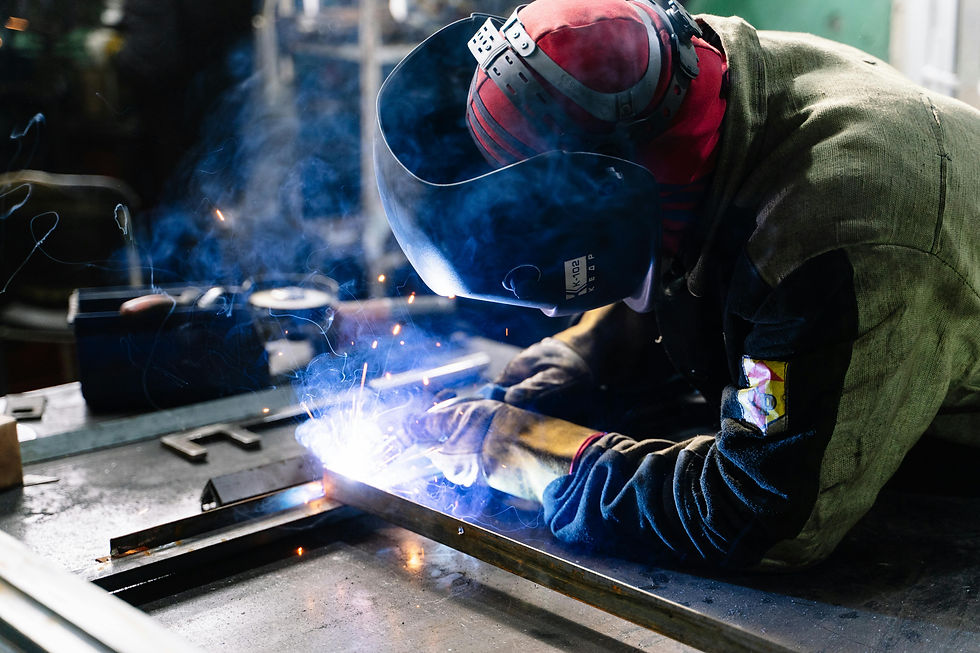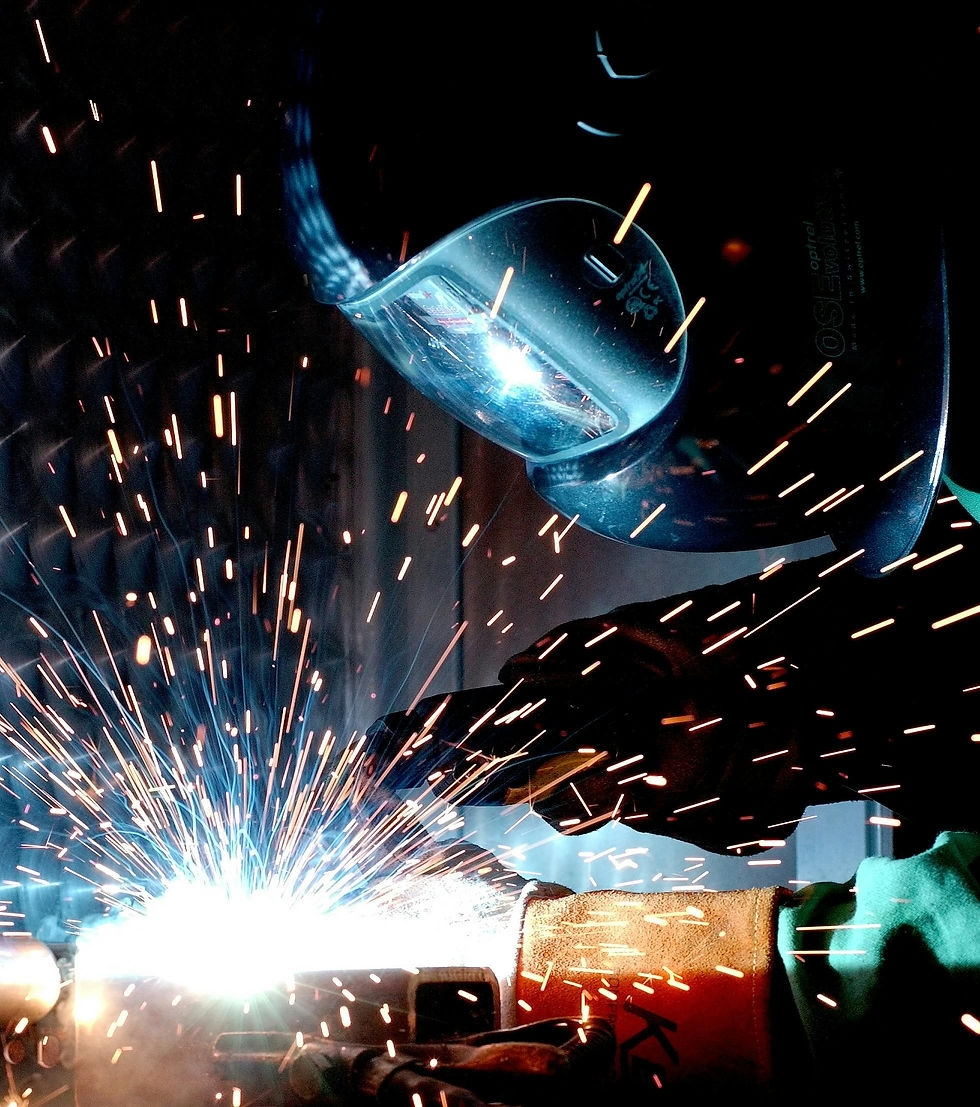The Best Welding: Techniques, Tools & Safety for Professionals
- adriana
- May 15
- 4 min read
Updated: May 16
Welding is more than just fusing metal - it’s the foundation of everything from bridges and skyscrapers to intricate art pieces and precision equipment. In the world of construction, manufacturing, and repair, welding is one of the most critical trades that quite literally holds industries together.

Image by Pavel Chernonogov
Whether you’re a seasoned welder running a fabrication shop or managing a team of industrial welders, choosing the right technique, tools, and safety gear can make or break your workflow. In this post, we’ll break down what makes for the best welding, from professional standards and equipment to industry-specific insights and expert-recommended accessories.
Defining “The Best” in Welding
When professionals talk about “the best welding,” they’re referring to more than just clean welds or minimal spatter.
The best welding practices prioritize:
Precision and structural integrity
Efficiency and speed
Operator safety
Cost-effectiveness
Adaptability across materials and applications
These standards apply across all major welding processes, whether it’s MIG, TIG, Stick, or Flux-Cored Arc Welding (FCAW).
Choosing the Right Welding Process
Let’s be clear: there’s no one-size-fits-all welding method. The best welding process depends on your project, material, and desired finish.
MIG (Gas Metal Arc Welding)
MIG welding is one of the easiest and fastest types of welding, making it a go-to for automotive, metal fabrication, and general repair work. It’s especially effective on thinner materials like stainless steel and aluminum.
Best for: Beginners and high-production environments
Pros: Fast, minimal cleanup
Cons: Not ideal for thicker materials or outdoor work
TIG (Gas Tungsten Arc Welding)
TIG welding is often seen as the gold standard for precision and beauty. It allows for the most control but demands skill and patience.
Best for: Aerospace, automotive detailing, artistic metalwork
Pros: Clean, high-quality welds
Cons: Slower, requires more practice
Stick (Shielded Metal Arc Welding)
Stick welding is rugged and versatile, capable of handling dirty or rusty materials and suitable for outdoor work.
Best for: Construction, pipelines, heavy equipment
Pros: Portable, works well in harsh environments
Cons: More slag, less finesse
Flux-Cored Arc Welding (FCAW)
FCAW is like MIG but uses a tubular wire filled with flux, making it suitable for outdoor and windy environments.
Best for: Structural steel, shipbuilding
Pros: High deposition rate, good for thick materials
Cons: Heavier equipment, more fumes
Tools and Equipment That Matter
The best welding starts with the best tools. And in a professional setting, investing in high-quality, durable equipment saves time, improves results, and reduces the risk of injury.
Welding Machines
For commercial and industrial use, multi-process machines offer versatility for teams that need to switch between MIG, TIG, and Stick. Brands like Miller, Lincoln Electric, and ESAB are widely respected.
Welding Helmets and Lenses
Auto-darkening helmets with high-clarity lenses are a must. Professionals often overlook the role of visibility in weld quality, but better optics lead to more consistent work and reduced strain.
Specialty lenses, such as gold-coated ones, enhance clarity, reduce glare, and improve color accuracy during the weld. Premium lenses can dramatically boost comfort and precision during long shifts. For top-tier lens options that enhance both safety and visibility, visit ridgeproductswelding.com.
Clamps and Jigs
Precision welding demands proper material alignment. Reliable clamps, jigs, and fixtures speed up the process and ensure consistent results across repetitive jobs.
Consumables
Quality filler metal, wire, and electrodes are just as important as the machine itself. Always match your consumables to your base material and welding process to avoid poor penetration, excessive spatter, or structural weakness.

Image by Patt Vielma
Safety Is Non-Negotiable
Welding may be rewarding, but it’s also dangerous. Fumes, high temperatures, arc flashes, and electric shock are serious hazards that require constant vigilance.
Essential PPE
Auto-darkening helmet (preferably with high-visibility lenses)
Fire-resistant gloves and clothing
Welding jacket or apron
Respirators or fume extractors
Steel-toed boots
Investing in quality safety gear not only protects workers but minimizes downtime due to injury.
Proper Ventilation
Welding fumes can contain toxic metals and gases. Ensure your workspace is well-ventilated, especially in enclosed areas. Use portable fume extractors when welding indoors or in tight spaces.
Advanced Techniques for Superior Welds
Professional welders know that technique separates a good weld from a great one. Here are a few tips and advanced tricks to elevate your results:
Preheat thicker metals to reduce cracking and promote better fusion.
Use a weave pattern for wide joints or thick metals—it improves coverage and penetration.
Clean your material before welding; contaminants reduce weld strength and appearance.
Check your travel speed—too fast results in poor fusion, too slow leads to excess build-up.
Dial in the amps and wire feed speed—adjust settings based on material thickness and type.

Image by Pixabay
Welding in Business: Efficiency and Profitability
If you run a welding business, your focus isn’t just on quality—it’s also about efficiency and profitability.
Optimize Workflow
Organize your workspace for quick access to tools
Standardize procedures and train your team accordingly
Automate repetitive tasks where possible (e.g., robotic welding for high-volume production)
Maintain Your Equipment
Regular maintenance avoids costly breakdowns and improves consistency. Clean machines, check for wear on cables and guns, and replace consumables before they fail.
Upskill Your Team
Invest in training to keep your welders sharp. Cross-train them on multiple processes to increase flexibility and reduce bottlenecks in production.
Final Thoughts: The Future of Welding is Smart, Safe, and Skilled
The best welding isn’t just about striking an arc, it’s about a balance of skill, technology, and smart business practices. Whether you're laying down flawless beads or managing a shop floor, the right tools and techniques make all the difference.
From precision TIG welding in aerospace to rugged Stick welding on job sites, every process has its place. Just remember: quality tools can elevate both safety and performance. With the right setup, training, and focus on innovation, your welding business can truly shine.

